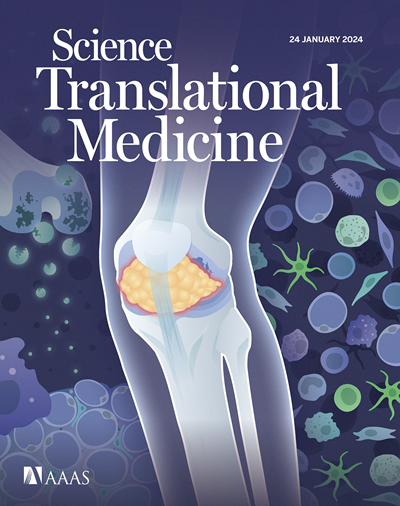A phase 1/2a clinical trial to assess safety and immunogenicity of an adenoviral-vectored capsular group B meningococcal vaccine
IF 15.8
1区 医学
Q1 CELL BIOLOGY
引用次数: 0
Abstract
Capsular group B meningococcus (MenB) remains an important cause of disease globally, and additional vaccines against MenB would aid in reducing the incidence of infection. Previous work has demonstrated that a MenB adenoviral-vectored vaccine, ChAdOx1 MenB.1, elicited high serum bactericidal responses in preclinical models after a single dose, supporting further clinical development of this vaccine. Here, we report the results of a trial designed to assess the safety and immunogenicity of ChAdOx1 MenB.1 in healthy adults aged 18 to 50. In this phase 1/2a, single-center trial, participants received one or two doses of ChAdOx1 MenB.1 at days 0 and 180. One dose of ChAdOx1 MenB.1 was also given at day 180 to some individuals primed with one dose of 4CMenB at day 0. Participants recorded their symptoms in an electronic diary after vaccination, and safety blood readouts were monitored. Serum bactericidal antibody (SBA) assays were performed against a panel of MenB target strains. ChAdOx1 MenB.1 was well tolerated with no safety concerns and elicited protective SBA titers against a MenB strain expressing a homologous factor H–binding protein (fHbp) variant in 100% of participants after two doses. However, cross-reactivity analysis indicated a low SBA response to strains expressing heterologous fHbp, suggesting that a multivalent vaccine may be needed. In sum, ChAdOx1 MenB.1 is immunogenic in humans, and addition of another fHbp variant or of another antigen in this platform could provide an approach to extend protection against endemic MenB disease.
一项评估腺病毒载体荚膜B组脑膜炎球菌疫苗安全性和免疫原性的1/2a期临床试验
荚膜B群脑膜炎球菌(MenB)仍然是全球疾病的一个重要原因,额外接种针对MenB的疫苗将有助于减少感染的发生率。先前的工作已经证明,一种MenB腺病毒载体疫苗ChAdOx1 MenB。1,在临床前模型中,单次给药后引起高血清杀菌反应,支持该疫苗的进一步临床开发。在这里,我们报告了一项旨在评估ChAdOx1 MenB的安全性和免疫原性的试验结果。18至50岁的健康成年人中有1例。在这项1/2a期单中心试验中,参与者接受了一剂或两剂ChAdOx1 MenB。第0天和第180天。一剂ChAdOx1 MenB。在第180天,也给一些在第0天接种一剂4CMenB的个体注射1。接种疫苗后,参与者在电子日记中记录他们的症状,并监测安全血液读数。血清杀菌抗体(SBA)测定针对一组MenB目标菌株。ChAdOx1 MenB。1耐受性良好,无安全性问题,在两次剂量后,100%的参与者对表达同源因子h结合蛋白(fHbp)变体的MenB菌株产生保护性SBA滴度。然而,交叉反应性分析表明,SBA对表达异种fHbp的菌株的反应较低,这表明可能需要一种多价疫苗。总之,ChAdOx1 MenB。1在人类中具有免疫原性,在该平台中添加另一种fHbp变体或另一种抗原可以提供一种方法,以扩大对地方性MenB病的保护。
本文章由计算机程序翻译,如有差异,请以英文原文为准。
求助全文
约1分钟内获得全文
求助全文
来源期刊

Science Translational Medicine
CELL BIOLOGY-MEDICINE, RESEARCH & EXPERIMENTAL
CiteScore
26.70
自引率
1.20%
发文量
309
审稿时长
1.7 months
期刊介绍:
Science Translational Medicine is an online journal that focuses on publishing research at the intersection of science, engineering, and medicine. The goal of the journal is to promote human health by providing a platform for researchers from various disciplines to communicate their latest advancements in biomedical, translational, and clinical research.
The journal aims to address the slow translation of scientific knowledge into effective treatments and health measures. It publishes articles that fill the knowledge gaps between preclinical research and medical applications, with a focus on accelerating the translation of knowledge into new ways of preventing, diagnosing, and treating human diseases.
The scope of Science Translational Medicine includes various areas such as cardiovascular disease, immunology/vaccines, metabolism/diabetes/obesity, neuroscience/neurology/psychiatry, cancer, infectious diseases, policy, behavior, bioengineering, chemical genomics/drug discovery, imaging, applied physical sciences, medical nanotechnology, drug delivery, biomarkers, gene therapy/regenerative medicine, toxicology and pharmacokinetics, data mining, cell culture, animal and human studies, medical informatics, and other interdisciplinary approaches to medicine.
The target audience of the journal includes researchers and management in academia, government, and the biotechnology and pharmaceutical industries. It is also relevant to physician scientists, regulators, policy makers, investors, business developers, and funding agencies.
 求助内容:
求助内容: 应助结果提醒方式:
应助结果提醒方式:


